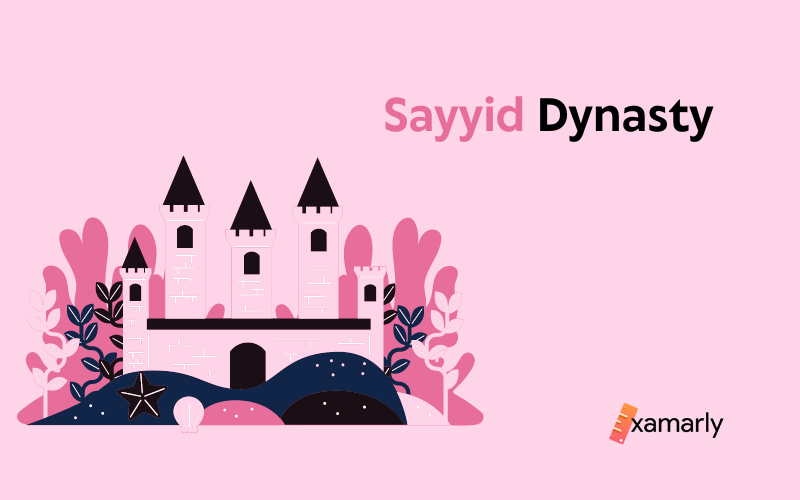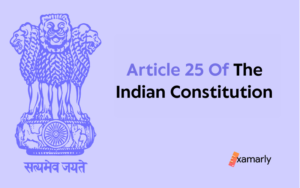Sayyid Dynasty superseded the Tughlaq dynasty and took the control of Delhi Sultanate in the year 1414 A.D and continued to be in power till 1451 A.D. This was the fourth dynasty to rule the Sultanate of Delhi.
The point is how did this Dynasty seize the power? Why Sayyid Dynasty was called so? How many rulers ruled the Delhi Sultanate under the name of this Dynasty? How this Dynasty came to end, and many more queries related to Sayyid Dynasty of Delhi Sultanate are gushing through your mind.
Thus this article will give you knowledgeable insight to quench your thirst regarding the Sayyid Dynasty. This article will be beneficial for the UPSC Preparation as this is a part of the UPSC Syllabus under the History of Medieval India.
Sayyid Dynasty History
Timur stormed Delhi in 1398 after switching his focus to India. Timur chose Khizr Khan as Multan’s deputy. Khizr Khan marched to Delhi and conquered it in 1414, cementing the Sayyid Dynasty. The Sayyid Dynasty was started by Khizr Khan, who did not, however, ever assume the sultan’s title.
Why Sayyid Dynasty Was Called So?
The Sayyid Dynasty’s kings proclaimed their claim to the throne on the grounds that they had a divine entitlement to do so. They asserted that they were descended directly from the Quraish Tribe, which included the Prophet Muhammad, the founder of Islam. The Sayyid Dynasty was the name given to the dynasty as the founder of Sayyid dynasty was Sayyid.
Sayyid Dynasty
Sayyid signifies descendants of Prophet. Its foundation was laid in the year 1414 A.D. by taking authority from the Tughluq Dynasty. Thereby laying a cornerstone for the four rulers to rule the Delhi Sultanate.
This Dynasty only lasted 37 years and was deposed by the Lodhi dynasty.
Sayyid Dynasty Rulers
Four Rulers ruled the fourth dynasty of the Delhi Sultanate. Read ahead to learn about these rulers.
Khizr Khan: Sayyid Dynasty Founder
- He established the Sayyid Dynasty.
- No regal title was sworn by him.
- He was Multan’s governor.
- He profited from the chaos that followed Timur’s invasion of India.
- He reigned as king of Delhi in the year 1414.
- He established control over a portion of Dilapur, Surat, and Punjab.
- However, he lost Gujarat, Malwa, Deccan, Jaunpur, Bengal, and Khandesh.
- He perished in 1421.
- Khizr Khan’s son Mubarak Shah succeeded him and rose to the power to rule the kingdom of Delhi.
Mubarak Shah
- Mubarak Shah came second in line to rule the fourth dynasty with the assumption of power in 1421.
- Khokhar and native Doab area chiefs were destroyed by Mubarak Shah.
- His appointment of Hindu nobility to the Delhi court makes him the first Sultan monarch to do so.
- On the riverbank of the Yamuna, Sayyid Mubarak Shah constructed the city of “Mubarakbad.”
- Wazir Sarwar-ul-Mulk assassinated Mubarak Shah, the king of the Sayyid dynasty, in 1434 whilst surveying the city of Mubarakabad.
- Muhammad Shah inherited the throne of the Delhi Sultanate from him. He was the nephew of Muizz-ud-Din Mubarak Shah.
Check out the linked article, to gain more information about Mubarak Shah.
Muhammad Shah
- Sultan Muhammad Shah ruled the Delhi Sultanate from 1434 till 1445 A.D.
- With the assistance of Bahlul Lodi, the Governor of Lahore, he overthrew the monarch of Malwa.
- For assisting in overthrowing the monarch of Malwa, he bestowed the title Khan-i-Khanan onto Bahlul Lodi.
- Ala-ud-din Shah took the power in his hand after the death of his father in 1445 A.D.
To learn more about Muhammad Shah, visit the linked article.
Ala-ud-din Alam Shah
- Alauddin Alam Shah came to the position of monarch in 1445 A.D. and enjoyed the rulership till 1451 A.D.
- He was a weak ruler to rule the Sultanate.
- He loved the luxuries of a regal existence and the benefits that came with it.
- In his sphere of authority, the plurality of kingdoms declared themselves independent.
- In the year 1451 AD, Bahlul Lodi, the governor of Lahore, deposed Ala-ud-din Shah.
- Alam Shah was moved to Badaun after Bahlul Lodi took control of Delhi.
- 1478 AD saw the death of Ala-ud-din Shah in Badaun.
To learn more about Alam Shah, visit the linked article.
Administration Of Sayyid Dynasty
- Kingship was very centralized throughout the Sayyid Dynasty, and the Sultan had unrestricted power.
- The administration of the Sayyid Dynasty was well-organized, with various ministers each allocated a certain task.
- In all spheres of state activity, the Sultan enjoyed limitless power as head of state.
- Naib occupied a position similar to the Sultans.
- Wazir served as the state’s prime minister and was in charge of the finances.
- Decisions were based on the Shariah. Cases involving non-Muslims were decided in line with those religions’ own laws.
- Larger or more significant provinces were led by governors who held more authority.
- Local government was primarily a traditional system, ambiguous and undefined.
- The empire was split into various large and minor territorial portions known as Iqtas.
To get more useful insight into Delhi Sultanate Administration, check out the linked article.
Economy
- Trade and the economy did not prosper throughout the Sayyid era.
- Sayyids imposed corn taxes, which Lodhi eventually eliminated.
- Supply lines in the Deccan region, which served as a marine trade route, broke down in the 14th and 15th centuries CE as a result of a drop in trading routes.
- The collapse resulted in a disruption of supplies from the coast to the empire.
- The weak economy ultimately caused the Sultanate to disintegrate.
Art And Architecture Of Sayyid Dynasty
Poor management and public turmoil characterized the Sayyid Dynasty. The rulers were unable to construct many buildings, and those that were constructed were of very poor quality because of a dearth of resources. As the Sultanate’s government changed, they, therefore, became victims of damage.
Among the structures and cities constructed during that time period are:
The Khizrabad City
Khizr Khan created Khizrabad while he was in power, however his reign was brief. It was also constructed around 1414 AD on the shores of the Yamuna River.
Mubarakabad City
Sayyid Mubarak Shah constructed the town of Mubarakabad while he was in power. On the Yamuna River’s banks, it was erected in the year 1433.
Tomb Of Sultan Mubarak Shah
Although the architecture of the Sayyid Dynasty is not very noteworthy, Mubarak Shah’s tomb stands out. It is among the most beautiful architectural creations from the period. It boasts a unique courtyard that is octagonal in design. Its unique strategy has piqued the interest of many people around the country.
Tomb Of Muhammad Shah
In 1444 CE, a mausoleum was constructed for Sultan Muhammad Shah. Presently, it can be found in the Lodi Gardens.
To learn more about the monuments, and Art And Architecture Of Delhi Sultanate, visit the linked articles.
Sayyid dynasty coins
- The coins still bore the name of the previous Tughlaq sultan and did not have the name of the Timurid king. There are no known coins bearing Khizr Khan’s name.
- During his first seven years in power, Mubarak Shah did not issue any coins in his own name, instead opting for posthumous kinds of Firuz Shah Tughluq and Muhammad bin Firuz. He minted some extremely uncommon gold and silver coins.
- Mubarak Shah produced his own coinage and used to have Khutbas recited in his name.
- Muizz-ud-Din Mubarak Shah was the name Mubarak Shah used on his coinage.
Reasons For The Decline Of Sayyid Dynasty
After Alauddin Alam Shah, the Sayyid Dynasty was over. When there was persistent opposition and rebellion under a weak monarch, the dynasty came to an end. The Dynasty’s control weakened through time, becoming unstable enough for someone to usurp it and ascend to the throne. Following is a list of the factors that contributed to the collapse of this dynasty:
- The Sultanate was troubled by internal uprisings in Jaunpur, Etawah, Gwalior, Doab, and other provinces during Mubarak Shah and Muhammad Shah.
- After his ascendancy, Muhammad Shah also cut links with regional kingdoms and professed no connection with them.
- Numerous uprisings consequently erupted throughout the northwest, northeast, and middle regions.
- The Sayyid dynasty’s rulers were unable to focus on governance and the welfare of the populace because they were too busy putting these uprisings down.
- The Sayyid dynasty was likewise brought down by the Khokhar uprising.
Court conspiracies and intrigues served to further accelerate the Sayyids’ collapse. - Alauddin Shah and Muhammad Shah, two succeeding kings, were not strong rulers.
- The dominance of the Afghans increased significantly during the administration of Alauddin Alam Shah, and Bahlul Lodi eventually become the king to rule the whole of Punjab.
- When Bahlul Khan Lodi conquered Delhi, Sayyid wazir Hamid Khan allied with Lodhi and assisted in overthrowing the Sayyid dynasty by installing him as the ruler of the Delhi Sultanate.
Dynasty That Succeeded The Sayyid Dynasty
Three years after Alauddin Shah willingly abandoned the throne and relocated to Badaun, Bahlul khan Lodi took the crown of Delhi, establishing the Lodi Dynasty. Thus, the 4th Dynasty was succeeded by the Lodi Dynasty. The fifth and final Delhi Sultanate dynasty was the Lodi Dynasty. The Mughals later took its place and established Mughal dominion in India.
Conclusion
The culture of India was significantly influenced by the Delhi Sultanate. Each dynasty left its distinctive mark on the area in which it reigned. Despite the fact that the Sayyid Dynasty’s kings generally valued peace, they invested a significant amount of time suppressing uprisings.
Due to the ongoing opposition and uprisings throughout the nation, it was simple to depose the reigning monarch and ascend to the throne. Bahlul Shah Lodi overthrew the Sayyid Dynasty and established the Lodi Dynasty.
FAQs
Who Was The Founder Of Sayyid Dynasty?
The founder of Sayyid Dynasty was Khizr Khan.
Who Was The Last Ruler Of Sayyid Dynasty?
The last sultan of Sayyid dynasty was Alauddin Shah.






